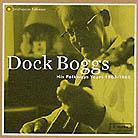June 1999
Such a cliché, however, evokes asphalt and turf grass, not the Kentucky mine-country soil in which Boggs’s art came to life. Boggs’s plain-talk singing and spare, resonant banjo picking evoke a world that predates studio arranging and is situated a thousand miles from the nearest symphony concert hall. In "Pretty Polly," for example, Boggs sounds like someone who has not seen thousands of models decked out for television and removed from daily reality but rather knew a living counterpart in his Kentucky mining town to "Pretty Polly … with rings on her fingers and lily white hands." But when Polly succumbs to the invitation of a former "rambler" to "take a walk with me," she guesses that "yo’ mind is to ramble and lead me astray." He tells her plainly she has guessed right -- he has already dug her grave. She sees a newly dug grave and "a spade lying by." The haunting ending of the song: "She threw her arms around him, began for to weep (twice)/And then Pretty Polly soon fell asleep." Fell asleep?! This must be quite the horrifying warning to a teenage country girl thinking of setting off on a picnic with a boy from down the road a piece. It also warns of men who don’t "settle down" and the need to trust one’s understanding and instinct as opposed to other people’s promises. Like most of the songs in this collection, it achieves its effects through concrete details and straightforward picking and singing. That is not to say the performances lack subtlety. The seemingly simple and repetitive banjo lines are so varied that even an accomplished banjoist would be hard put to imitate an entire Boggs song perfectly. Barely perceptible ornamentation in Boggs’s singing provides some of the songs’ emotional content without whooping, screaming, growling, or moaning. This is one of the many ways in which Boggs is a folksinger’s folksinger, reminding us of most of the songs’ non-commercial pre-recording-industry origins. The 10 titles "Danville Girl," "John Henry," "Careless Love," "Coal Creek March," "I Hope I Live a Few More Days," "Prodigal Son," "Mistreated Mama Blues," and "Prayer of a Miner’s Child," and "Railroad Tramp" suggest the range of the 50 songs’ themes. Paradoxically, of course, we would not be able to treasure vast amounts of folk music if not for the recording industry, even if it was the perseverance of Mike Seeger, who tracked down Boggs in the hills with a Nagra tape recorder lent to him by his half-brother Pete, to which we owe the only known Dock Boggs recordings other than 12 tracks from the 1920s. These songs were not created by aspiring "recording artists" pursuing "singer-songwriter" careers. They evolved over many years, some of them over several generations. They convey the moral, religious, and material life of Americans whose lives consist of, water, greens, gravy, grease, whiskey, home, church, coal mines, railroads, jails, graves, pickaxes, guns, knives, fists, weddings, babies, funerals, soil, sky, heaven, hell, horses, mules, chickens, dogs, turkeys, and of course songs -- not of word processing, family rooms, chlorine, television, ice hockey, Gatorade, school boards, voice mail, smart bombs, health food, brewpubs, annual reports, natural childbirth, Zantac, Air Jordans, you name it. His Folkways Years sounds just fine, as if recorded on a good tape recorder in Boggs’s sister’s house -- as most of it was. As suggested by Simon & Garfunkel’s issuing a take of "Cecelia" recorded in a living room despite their typically recording in state-of-the-art studios, the "folk" in "folk music" indicates maximum technology is not necessary -- it is folk music if you can hear it and you don’t need a band to play it. And it may be less "folk" the more it is fussed with. This two-CD set is a folk-music-lover’s treasure -- that is for sure. GO BACK TO: |
 Dock Boggs
- His Folkways Years, 1963-1968
Dock Boggs
- His Folkways Years, 1963-1968![[Reviewed on CD]](../format/regcd.gif) In his
essay that accompanies Dock Boggs: His Folkways Years, 1963-1968, Barry
O’Connell says of Boggs, "[T]hrough his music he transmuted the everyday into
something more beautiful and startling and acute than we are usually able to feel."
One can hardly articulate more effectively the essence of the 50 songs on this
Smithsonian Folkways 2-CD re-release of the 1960s Folkways Records three-LP Dock Boggs
recordings. The plain yet deeply engaging singing voice and deceptively simple banjo style
-- the only accompaniment is Mike Seeger’s guitar on some of the tracks -- might move
one to describe these tracks as "earthy."
In his
essay that accompanies Dock Boggs: His Folkways Years, 1963-1968, Barry
O’Connell says of Boggs, "[T]hrough his music he transmuted the everyday into
something more beautiful and startling and acute than we are usually able to feel."
One can hardly articulate more effectively the essence of the 50 songs on this
Smithsonian Folkways 2-CD re-release of the 1960s Folkways Records three-LP Dock Boggs
recordings. The plain yet deeply engaging singing voice and deceptively simple banjo style
-- the only accompaniment is Mike Seeger’s guitar on some of the tracks -- might move
one to describe these tracks as "earthy."